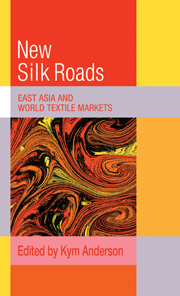Book contents
- Frontmatter
- Contents
- List of figures
- List of tables
- Contributors to this volume
- Preface
- Abbreviations and acronyms
- Symbols
- Introduction and summary
- I FIBRES, TEXTILES AND ECONOMIC DEVELOPMENT
- II DEMAND FOR TEXTILE EXPORTS FROM NEWLY INDUSTRIALIZING ASIA
- 5 The Multi-fibre Arrangement and China's growth prospects
- 6 International competition and Japan's domestic adjustments
- 7 The new silk road to Europe
- 8 The redirection of United States imports
- 9 Structural adjustments in Australia and New Zealand
- III CONCLUSIONS
- Appendix: Data on world production, consumption and trade in textiles, clothing and fibres
- Bibliography
- Index
7 - The new silk road to Europe
Published online by Cambridge University Press: 19 January 2010
- Frontmatter
- Contents
- List of figures
- List of tables
- Contributors to this volume
- Preface
- Abbreviations and acronyms
- Symbols
- Introduction and summary
- I FIBRES, TEXTILES AND ECONOMIC DEVELOPMENT
- II DEMAND FOR TEXTILE EXPORTS FROM NEWLY INDUSTRIALIZING ASIA
- 5 The Multi-fibre Arrangement and China's growth prospects
- 6 International competition and Japan's domestic adjustments
- 7 The new silk road to Europe
- 8 The redirection of United States imports
- 9 Structural adjustments in Australia and New Zealand
- III CONCLUSIONS
- Appendix: Data on world production, consumption and trade in textiles, clothing and fibres
- Bibliography
- Index
Summary
There are two major developments taking place in Europe which will have implications for East Asia's trade with this region. First, the European Community (EC) is deepening the political and economic integration among its members through the creation of the so-called ‘Internal Market’ program to be concluded by 1992. Second, Eastern Europe is undergoing political and economic liberalization. From an economic point of view, and in the short run, the EC's 1992 program is the more important of the two developments. In the long run, however, provided the present economic and political liberalization is allowed to continue, the events in Eastern Europe could be more important economically, and certainly more important politically.
The first section provides some background information regarding clothing production historically in Western Europe, as well as more recent trade flows and apparent consumption of textiles and clothing. In the second section the EC's textile trade policy during the 1980s is analysed. New estimates are presented regarding the restrictiveness of EC voluntary export restraints (VERs) under the Multi-fibre Arrangement (MFA), as well as new estimates of selected countries' supply prices of clothing. Against this background, the third section discusses aspects of the EC's prospective future trade policy, particularly the changing role of its anti-dumping instrument, the emergence of new suppliers with preferential access, and an analysis of future conflicts of interest between ‘sun-belt’ protectionist EC countries and ‘frostbelt’ liberal members over the openness of the Community. The conclusions are summarized in the final section of the chapter.
- Type
- Chapter
- Information
- The New Silk RoadsEast Asia and World Textile Markets, pp. 119 - 147Publisher: Cambridge University PressPrint publication year: 1992

